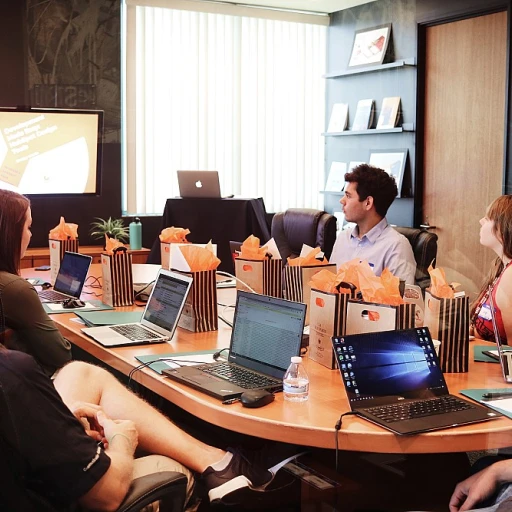
Understanding the Need for Reskilling
Why Reskilling is a Modern Necessity
In today's fast-paced business environment, the demand for new skills has skyrocketed, pushing organizations to rethink their approach to employee development. As technology continues to evolve, driven by innovations like Microsoft solutions and data integration, businesses are faced with a critical need to ensure their teams remain competitive and effective. Without a doubt, the job market is shifting rapidly. As automation and edge technology become more prevalent, the proficiency required for various roles is being redefined. This change necessitates organizations to not only embrace reskilling strategies but also foster an environment where collaboration solutions can thrive, enabling seamless teamwork in the process. Many businesses are already integrating cutting-edge, data-driven solutions to enhance operational efficiency. Collaboration solutions have increasingly become the cornerstone of effective reskilling strategies. They provide the tools necessary for teams to work collectively, adapt to new roles, and meet the ever-evolving demands of their customers. When teams are equipped with the best practices and services that allow for seamless integration of new skills into their day-to-day operations, the results are nothing short of transformative. Furthermore, reskilling isn't limited to just traditional classroom settings. Organizations are now leaning toward more collaborative experiences, leveraging consulting services to create tailored plans that cater to the unique needs of their workforce. The implementation of collaborative solutions not only boosts efficiency but also enhances the overall experience of employees, enabling them to meet customer demands with greater agility. For those interested in delving deeper into reskilling methods, exploring effective competency-based training methods can offer valuable insights. Exploring effective competency-based training methods can provide a pathway to better understanding how reskilling can be efficiently applied and optimized within your organization.The Role of Collaborative Solutions in Reskilling
Leveraging Collaborative Strategies for Skill Development
In today's business landscape, reskilling has become a crucial part of maintaining operational efficiency and competitiveness. By implementing collaborative solutions, organizations can foster an environment where teamwork thrives, and skills are effectively developed. This collaborative approach not only enhances teamwork but also integrates cutting edge technology to improve learning experiences.
Collaborative experiences are vital in reskilling as they leverage the collective knowledge and expertise within a team. Through the integration of microsoft solutions and other tools, teams are empowered to work seamlessly and in real time, facilitating the exchange of ideas and skills. This seamless interaction is especially important in remote work settings where collaboration solutions enable remote employees to engage with their peers effectively. The use of data driven approaches further ensures that skill gaps are identified and addressed promptly.
Consulting services play a pivotal role in guiding organizations on how to effectively implement these collaborative strategies. By providing services help and services collab, consulting firms aid in designing tailored solutions that align with business objectives. With contact center solutions, businesses can maintain a direct line of communication, ensuring that any issues are promptly addressed and that the customer experience is not compromised.
Adopting collaboration solutions within reskilling initiatives not only aids in the enhancement of teamwork but also offers the unique opportunity for continuous learning. By creating a culture where employees are encouraged to learn and collaborate, organizations cultivate a dynamic and adaptable workforce. For further insights on enhancing the learner experience, Bersin's insights provide valuable perspectives Enhancing the Learner Experience with Bersin's Insights.
Implementing Collaborative Solutions Effectively
Streamlining Implementation for Maximum Impact
Implementing collaborative solutions for reskilling demands a structured approach that integrates technology with human-centric strategies. Businesses must adopt best practices that ensure these solutions are not only theoretical but practically viable in improving teamwork and efficiency. By leveraging tools such as Microsoft solutions, organizations can create a seamless integration of collab solutions that support real-time and remote competencies fostering operational efficiency.
The first step in effective implementation is to align the reskilling objectives with business goals. This alignment ensures that the services provided are directly enhancing specific operational needs. Seamless collaboration among teams is critical here. Encouraging open communication allows for shared experiences and better management of resources, enabling learning to happen more fluidly across different team members. This collective approach helps in managing diverse customer needs and navigating through complex work environments.
Leveraging cutting-edge technology aids in this process. Technologies such as data-driven collaboration solutions offered by Microsoft have made it possible to track progress and manage resources effectively. These tools are crucial for enabling seamless contact with clients and optimizing resource management, ensuring that every part of the team can access integrated data and contribute meaningfully to the organizational goals.
Operational efficiency hinges not merely on technology but also on the experiences of the personnel involved. Incorporating training and consulting services can help bring teams up to speed with the new systems, leading to a more cohesive and efficient work output. As these initiatives progress, continuous evaluation and adaptation are essential to refine processes, ensuring they meet the evolving needs of the business landscape.
For those looking to implement cutting-edge strategies in their reskilling initiatives, delving deeper into resources such as enhancing your technical skills for a new career path can provide additional insights and tools to bolster this transformative journey.
Overcoming Challenges in Collaborative Reskilling
Navigating Challenges in Team-Based Reskilling Efforts
In any reskilling initiative, especially those involving collaborative solutions, challenges can manifest in various forms. Acknowledging these hurdles is the first step towards overcoming them and ensuring seamless integration of learning solutions that enhance a company's operational efficiency. To begin with, the integration of new technology and collaborative solutions, such as those offered by Microsoft services, can be daunting. Companies sometimes struggle with managing change, especially when introducing cutting-edge technology that requires a shift in business processes. A precise action plan is essential for easing the transition and optimizing collaboration within teams. Moreover, fostering seamless teamwork across diverse groups may also require targeted data-driven approaches. Ensuring everyone is on the same page and working towards the same goals is key in minimizing confusion and promoting efficient work outcomes.- Technology and Data Integration: Leverage collaborative solutions like Microsoft’s suite to create an environment that supports real-time communication and data integration. Tech solutions must be user-friendly and set up to provide seamless customer experiences for maximum efficiency.
- Effective Communication: Using state-of-the-art communication tools can enable remote work and improve contact center operations. Facilitating clear and consistent communication within teams and with clients is important for understanding and learning together.
- Tailored Consulting Services: Professional consulting services can provide critical support tailored to meet organizational needs, particularly when addressing complex business challenges. They help equip teams with strategies to close skill gaps through tailored learning solutions.
Measuring the Impact of Collaborative Reskilling
Assessing the Outcomes of Collaborative Reskilling Initiatives
To gauge the success of collaborative solutions in reskilling, businesses must employ a comprehensive evaluation strategy. This involves both quantitative and qualitative metrics to accurately reflect the true impact on team efficiency and service delivery. In the realm of technology and business, understanding these metrics can guide future reskilling efforts.
One critical aspect to measure is the operational efficiency achieved post-reskilling. By analyzing key performance indicators such as customer satisfaction, service delivery rates, and client feedback, businesses can discern the real-time effects of reskilling initiatives. Microsoft's cutting-edge technologies can facilitate this process with seamless integration of data-driven insights into everyday work practices.
Another focal point involves the collaboration experiences of teams that partook in reskilling. Through surveys and feedback forms, management can gather valuable insights into how collaborative solutions have improved team dynamics. The implementation of collab solutions further fosters enhanced communication, which is paramount for continuous improvement of team performance.
Businesses should also leverage Microsoft solutions and other center solutions to maintain a centralized contact center for collecting and analyzing data on reskilling outcomes. This supports the identification of best practices, promoting a culture of continuous learning and adaptation. The goal is not only to meet current needs but to prepare teams for future challenges by enabling remote collaboration and ensuring services provide operational efficiency.
In conclusion, measuring the impact of collaborative reskilling is essential for improving current strategies and planning future initiatives. It helps organizations understand the effectiveness of their solutions collab and ensures the workforce remains agile and prepared for evolving demands.













